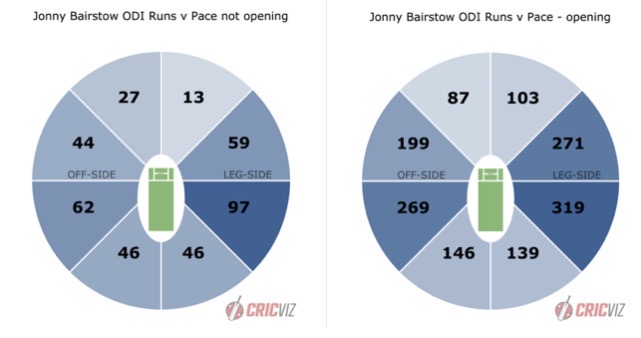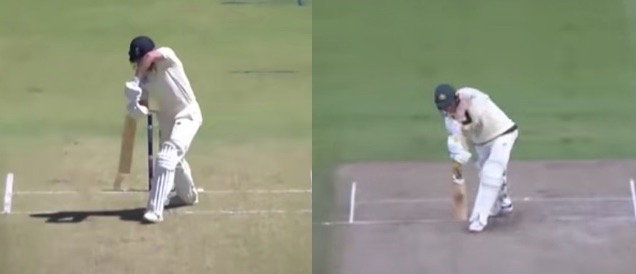
CricViz analyst Freddie Wilde examines the undulating fortunes of Jonny Bairstow’s international career
CricViz analyst Freddie Wilde examines the undulating fortunes of Jonny Bairstow’s international career and seeks to identify why he has struggled to combine red- and white-ball dominance.
Jonny Bairstow’s international career can be divided into three clear periods. His first stint in the Test team spanned between August 2012 and January 2014, at which point he was dropped having returned 593 runs in 14 matches at an average of 26.95. Bairstow then remodelled his technique in a major way and forced his way back into the Test side through sheer weight of runs on the domestic circuit. Bairstow’s new technique reaped bountiful rewards: in the following two years he scored 1,842 Test runs at an average of a fraction below 50. It seemed as if he was finally fulfilling his enormous talent.
Then, in June 2017, when Jason Roy was dropped from the ODI team for the 2017 Champions Trophy semi-final, Bairstow – whose ODI career comprised just 26 matches at that point – was promoted to open the batting in ODIs. This move up the order was the making of Bairstow as an ODI player – setting him on the path to modern-day greatness – but it appeared to trigger subtle technical changes which have seen his red-ball returns plummet. Since June 2017, Bairstow has scored 2,276 runs in ODIs at an average of 51 at a rate of more than a run a ball, but in Tests he has only scored 1,595 runs at an average of 28, leading him to lose his place England’s red-ball side.

These various phases and changes – the technical overhaul, the red-ball rise, the ODI promotion, the further technical tweaks and the white-ball surge – may, of course, be unrelated. However, using a combination of CricViz data and video it is possible to more clearly examine this fascinating career trajectory and seek to identify the reasons for Bairstow’s undulating fortunes.
The remodelling
In a video posted by the ECB on YouTube in July 2016 – the peak of Bairstow’s red-ball rise – he explained the changes he made to his technique and why he made them. Broadly, the adjustments amounted to standing taller in his stance and holding his bat higher.
The image on the left shows Bairstow on Test debut in 2012; the image on the right shows Bairstow batting against Pakistan in 2016. The difference is clear.

“Coming into the side [in 2012] I was quite low-crouched, my front-arm and elbow was straight and rigid, which made my chest and my back and everything else very rigid as well, and it became very mechanical instead of being natural, which is what sport should be,” Bairstow explained.

“The reason why I’ve gone with my high hands is because everyone had seen that my backlift was low before, and I was going low and then back up, and I felt like I was playing the ball out in front of myself. So I feel with my hands a little bit higher, I’m playing the ball a little bit later because my hands have got further to travel. Also with my backlift starting higher it is not going as low to come back up which is hopefully giving me slightly more time.”

The success of the changes that Bairstow made are most obviously measured by the enormous increase in runs and batting average. There are, however, finer details that help explain his greater output.
In the first phase of Bairstow’s career – and, as we will later examine, in the most recent phase – he was regularly dismissed bowled by pace bowlers. Between 2012 and 2014, 33 per cent of his dismissals against the quicks were bowled, well above the average for top order batsmen of 20 per cent. This was part of a broader issue with straight balls more generally: in his first stint in the side Bairstow averaged just 9.66 against balls on his stumps – again, well below the average of 18.17 for top order batsmen.
Bairstow’s problem was that he went hard at the ball, playing out in front of his body. It seems that this issue was the stimulus for the technical changes he made because in the ECB video he references his higher hands giving him “more time” and allowing him to “play the ball later”.
The changes had their desired effect. Ball-tracking data shows how between 2015 and June 2017 Bairstow played the ball a lot later, was bowled much less often and averaged significantly more against balls on his stumps.

The ODI promotion
Then came the promotion to the top of the order in ODIs and things started to change. The new role as opener saw Bairstow very subtly shift his set-up towards the leg side, something that has become increasingly pronounced over time. This move may well have been driven by a desire to exploit the fielding restrictions in the first 10 overs when only two fielders are permitted outside the 30-yard circle – these are typically positioned at third man and square leg – which encourages batsmen to hit in front of square on the off side. Standing slightly more leg side of the ball therefore opens up access to this area. Fielding teams generally leave this off side boundary vacant partly to encourage batsmen to attempt to hit there which brings the slips into play, but in modern ODI cricket the white ball swings and deviates less, so hitting through the off side is not as risky as it used to be.

The image on the left shows Bairstow batting at No.6 for England, in their famous series-sealing win against New Zealand in Chester-le-Street in 2015. The image on the right then shows him in his first innings opening the batting for England, in their Champions Trophy semi-final against Pakistan.

The difference in Bairstow’s location on the crease is very clear and this shift towards the leg side is further illustrated by his average impact points against pace by series.

Line impact points are of course partly determined by the line that bowlers are bowling: the straighter they bowl, the straighter the impact point is likely to be and as Bairstow exposes his stumps the more likely they are to bowl straighter, therefore making his impact point straighter. However, there is a discernible trend in Bairstow’s impact points before and after opening the batting, enough to at least partly attribute that to his more leg-side set-up. On average he has made impact with the ball 7 cm further towards the leg side since opening the batting.

Just as with his higher backlift improving his record against straight balls in Tests, Bairstow’s shift towards the leg side brought the desired result. A comparison of Bairstow’s wagon wheels before and after opening the batting show how he has become far more effective at scoring through the off side.

Bairstow has now established himself as one of the world’s best ODI batsmen. Since he first opened the batting for England, only four players have scored more runs and none of them have done so at a faster run rate. Bairstow’s ODI exploits earned him a contract at Sunrisers Hyderabad in the IPL where he had a sensational first season in 2019, scoring 445 runs in just 10 matches.
The Test decline
While Bairstow’s white-ball game has soared, the reverse has happened to his red-ball game, with his average plummeting from almost 50 in the period between returning to the Test side and to becoming ODI opener to 28 since then.
A closer analysis of Bairstow’s Test batting across his career makes it clear that his post-ODI opening decline has come about almost entirely as a result of his deteriorating returns against pace bowling. His average against spin has remained above 40 but his average against pace has dropped significantly.

In addition to this, using CricViz’s advanced eXpected Runs and Wickets (xR and xW) models, we can place Bairstow’s decline against pace bowling in greater context. The xR and xW models evaluate bowling quality based on the ball tracking components of any set of deliveries. This analysis shows that the pace bowling Bairstow has faced in Tests since becoming an ODI opener has been notably more difficult than it was before then, with the expected batting average from the balls he has faced falling from around 33 to 27. It is worth saying that eXpected Average is based on how the model would expect an average Test player to perform against those deliveries and we would typically expect a batsman such as Bairstow to outperform it fairly comfortably. It is telling – and appropriate – therefore that the two periods when he has underperformed relative to this measure have cost him his place in the team.

Bairstow’s Test struggles of recent years have been marked by a very familiar theme to his first decline – specifically going hard at the ball, being bowled often and struggling with straight balls. Since Bairstow became an ODI opener, the proportion of his dismissals against pace that have been bowled has climbed back up to around one in three, while his average against balls that would go onto hit the stumps has fallen even lower to a woeful 6.53. Bairstow’s 35 per cent of bowled dismissals from quicks since June 2017 is, remarkably, the highest of any Test batsman in the world in this period with a minimum of 1,000 balls faced.

Essentially, the problems that plagued Bairstow’s game before he was dropped for the first time and before he remodelled his technique have returned, and they’ve done so with a vengeance. The big question, of course, is why?
A key factor has been the difficulty of batting. As we identified above, the balls Bairstow has faced in recent years have been harder to keep out – and this has been a trend the world over – due to excellent bowlers and some tricky conditions.
Since Bairstow has become ODI opener the balls he has faced in Test cricket have swung less than those he faced between 2015 and June 2017 but they have deviated off the pitch significantly more and seam movement, because it happens later, is more difficult to counter than swing.

There is no doubt that the difficulty of Test batting in recent years has contributed to Bairstow’s decline. However, Bairstow’s old wounds being reopened so dramatically and his average falling so significantly suggest that there is more at play here.
At this point it is worth saying that seeking to identify why this might have happened is ultimately speculation: it is difficult to prove anything conclusively. However, one theory is that the changes Bairstow adopted in 2017 that have made him such an effective white-ball batsman may have had a deleterious effect on his red-ball game.
The technical adjustments in 2014 – the more upright stance and the higher backlift – enabled Bairstow to access the ball better, play it later and generally deal with straight bowling far more effectively. However, the concern now is that these changes have combined with his slight shift towards the leg side – initiated by his ODI batting – and have thrown his Test batting out of kilter.

The image on the left shows Bairstow in his stance in 2016 against Pakistan; the image on the right shows Bairstow in his stance against Australia in 2019. The difference is only marginal but in the 2019 image you can clearly see that Bairstow is standing more leg side, exposing more of his stumps.
Plainly speaking the white ball moves less than the red ball. Standing leg side of the ball, opening up the off side and swinging through the line of the ball works in ODIs precisely because the ball moves so little laterally. In Test cricket, and particularly Test cricket in the last couple of years, that is not the case. A simple comparison of the lateral movement Bairstow has encountered in red- and white-ball formats illustrates the huge difference between the two games.

The concern with the third incarnation of Bairstow as a Test batsman is that too often he allows the bowler a sight of his off stump. This is a dangerous game in red-ball cricket– particularly when driving– and leaves Bairstow reliant on exceptional hand-eye coordination to protect his stumps from being disturbed by lateral movement, particularly off the pitch, of which there has been plenty in the last two years.
The two screen-grabs below show Bairstow, on the left, and Marnus Labuschagne, on the right. These two shots have been chosen because the balls bowled are almost identical. Bairstow’s is around 50cm shorter but they would’ve passed the stumps on an almost identical line – precisely 24 and 22cm outside the line of middle stump. Both balls are hit sweetly for four but note how Bairstow hits his through cover, while Labuschagne plays straighter, punching his back down the ground. Note also how Bairstow’s entire off stump and even the edge of his middle stump is visible while none of Labushagne’s stumps are.

Ultimately no two players are the same and while it is slightly disingenuous to compare them it can be a useful exercise. The screen-grabs above show one player whose game has been shaped by white-ball cricket and one whose game has scarcely been touched by it.
The divergence
The theory that white-ball cricket has affected Bairstow’s Test batting should not be conflated with the more general outlook that all white-ball cricket is bad for red-ball cricket. The white-ball formats have lent much to all aspects of the Test game, not least by making them more interesting, exciting and varied spectacles.
However, there is a more specific point about the evolution of skills here. Players have always, to varying degrees, preferred one format to another. However, there is evidence to suggest that the red- and white-ball formats are moving away from one another at such a rate that modern players are struggling to bridge the divide, and Bairstow’s career is the latest case study.
Across the last decade we have seen a remarkable divergence in the art of spin bowling across red- and white-ball formats, and we have now reached a point where no major international team has a frontline spin bowler who is a guaranteed selection in both red- and white-ball cricket. Essentially the games have become so different that they demand entirely different skillsets of their practitioners.
This divergence has not yet been so clearly felt in batting, but the nature of bowling – they put the ball in play – has meant that their separation was always likely to come first. As the bowling changes take effect this may in turn then have knock-on consequences on the nature of batting. This change could prove to be self-perpetuating: as the formats move away from one another, skills are likely to become increasingly specialised, which will, in turn, demand greater specialisation to respond to those elevated skills.
Across the last decade white-ball batting has become increasingly defined by attacking play, due largely to the lack of lateral movement in the air or off the pitch, but at the same time, red-ball batting has become increasingly defined by defensive play, due largely to the extent of movement in the air and off the pitch.
Bairstow has, across different periods in his career, averaged 50 in Tests and 50 in ODIs but been unable to do so simultaneously as the two games have moved further away from one another. So, perhaps Bairstow’s struggle, and to a lesser extent the difficulties faced by the likes of Martin Guptill, Aaron Finch, Alex Hales, Jason Roy and KL Rahul, point to the game’s future, heralding an age where being a cross-format batsman becomes the preserve of only the game’s most rarefied talents.








